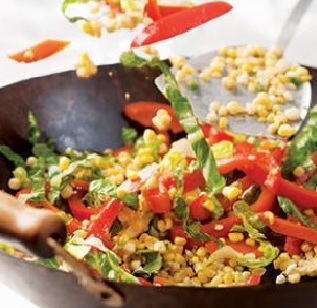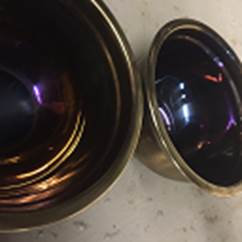Deep dishes, pans and woks can be made GoldenBlue®. Even cast iron surfaces can be fully made nonstick (without seasoning). The treatment can be used for corrosion prone pipes as corrosion is seemingly vastly reduced.
What is the simplest test one can perform to ascertain Non-Stick properties of a surface? Please scroll to the bottom of the page for the answer. These tests should be done over the life of a pan/utensil.
Answer: The most important tests are the release efficiency and ease of cleaning discussed at the bottom of this page. A very simple test though could be a drying test. Non-stick surfaces seem to dry a bit more slowly when compared to their counterparts regardless of wettability. They may both dry fairly rapidly, but the non-stick appears to always dry a bit more slowly. To do the test one can drop a fixed volume of water on the surfaces to be compared and record the drying time. The temperature affects the process. Although not definitive by any means, this test seems very simple and useful. Sometimes an incline roll-off test is also done to ascertain speed of release, however for this test one should carefully check for any film left behind in the roll-off test. Wettability and Non-Stick are not the same properties. Wettable may in fact indicate stickiness as it depends on the particular liquid and the temperature of the test surface. Type of Tests that MHI recommended for Non-Stick Surfaces: Release, Incline, Permanency and Scratch Tests…. and most importantly the four main questions asked below which have to do with release. Stick and Non Stick surfaces generally behave very differently during cooking and cleaning. Cooking oils have a smoke temperature of about 180-260°C. Closer to this temperature or when exceeded, the non-stick surface properties change – so it is very important to examine the two practical aspects of ‘release’ and ‘ease of cleaning’ across the entire cooking and cleaning process as good measures for determining non-stick behavior. * Please note that no claim is made or intended to suggest that the GoldenBlue™ is for cooking or food contact. Such a claim has not been tested. Food contact surfaces need to be approved by the proper US Government agency. This has not been submitted or carried out for GoldenBlue™ service or dish. GoldenBlue® surface is a steel or alloy surface with no extra additives.


Case Study: Boiling milk in non-stick GoldenBlue™ dishes
In many parts of the world, milk is boiled daily in all homes. This process leaves behind a sticky residue which is difficult to clean. In order to test the efficacy of GoldenBlue™, one cup of whole milk was boiled in both GoldenBlue® and uncoated stainless steel pans. The results were significant. In the coated pan, most of the milk solids floated to the outer rim of the milk and did not adhere to the bottom of the pan. In the original pan, the milk solids settled uniformly over the surface that was exposed to the milk. This made it difficult to clean. The stick-resistance of the GoldenBlue® pan made it’s cleaning remarkably easier when compared to the identical original pan.
What are the comparative non-stick release characteristics measured by MHI for GoldenBlue™ spoons compared to the original spoons?
| Spoon 1 – Original – no coating | Spoon 2 – GoldenBlue® |
|---|---|
Peanut Butter Experiment: The entire spoon was covered with peanut butter. The spoon was tapped on the side of a bowl, no peanut butter was released into the bowl. This is stick. Ease of cleaning: held the spoon under warm running water and rubbed with fingers, peanut butter film remained on the spoon, soap was required to remove and clean. Compare with adjacent spoon for GoldenBlue® results. Marshmallow Cream Experiment: The entire spoon was covered with marshmallow cream. The spoon was on the side of a bowl, no marshmallow cream was released into the bowl. This is stick. Ease of cleaning: held the spoon under warm running water and rubbed with fingers, marshmallow cream remained on the spoon, soap was required to remove and clean. Compare with adjacent spoon 2 results. Pizza Dough Experiment: The entire spoon was covered with pizza dough. The spoon was tapped on the side of a bowl, minimal amounts of pizza dough were released into the bowl. This is stick. Ease of cleaning: held the spoon under warm running water and rubbed with fingers, pizza dough remained on the spoon, soap was required to remove the rest and clean the spoon. Compare with adjacent spoon 2 results. Pancake Batter Experiment: The entire spoon was covered with pancake batter. The spoon was tapped on the side of a bowl, minimal amounts of pancake batter were released into the bowl. This is stick. Ease of cleaning: held the spoon under warm running water and rubbed with fingers, pancake batter remained on the spoon. Soap was required to remove the rest and clean. Compare with adjacent spoon 2 results. | Peanut Butter Experiment: The entire spoon was covered with peanut butter. The spoon was tapped on the side of a bowl, large amounts of peanut butter were released into the bowl. This is easy release. Ease of cleaning:held the spoon under warm running water and rubbed with fingers, peanut butter was quickly removed leaving no film residue with only the water rinse. Marshmallow Cream Experiment: The entire spoon was covered with marshmallow cream. The spoon was tapped on the side of a bowl, minimal amounts of marshmallow cream were released into the bowl. This is easy release. Ease of cleaning:held the spoon under warm running water and rubbed with fingers, marshmallow cream was quickly removed leaving no sticky residue with only the water rinse. Pizza Dough Experiment: The entire spoon was covered with pizza dough. The spoon was tapped on the side of a bowl, average amounts of pizza dough were released into the bowl. This is easy release. Ease of cleaning:held the spoon under warm running water and rubbed with fingers, pizza dough was quickly removed, leaving no residue with only the water rinse. Pancake Batter Experiment: The entire spoon was covered with pancake batter. The spoon was tapped on the side of a bowl; large amounts of pancake batter were released into the bowl. This is easy release. Ease of cleaning: held the spoon under warm running water and rubbed with fingers, pancake batter was quickly removed leaving no residue with only the water rinse. |
Summary Comparison
The GoldenBlue® spoons were noticeably easier to clean i.e. required less time and effort to clean.
| Frying Pan Original Surface – no coating | Frying Pan GoldenBlue® |
|---|---|
| Experiment: Fried eggs (sunny-side up) were made on both a coated and the uncoated frying pan, holding the amount of oil, heating constant. | Experiment: Fried eggs (sunny-side up) were made on both a coated and the uncoated frying pan, holding the amount of oil, heating constant. |
|
|
Best non-stick surface questions?
1. Does the cooked food peel off reliably time after time? Are the release characteristics attractive? Yes for GoldenBlue™!
2. Is it easier to cook on and easily clean the new surface? Yes for GoldenBlue™!
3. Can one use metal spatulas or hard scrappers during cooking and yet not spoil the surface? Yes for GoldenBlue™!
4. Does the surface spoil permanently when overheated beyond the smoke temperature? No for GoldenBlue™.







 MHI Inc. USA
MHI Inc. USA MHI Inc. USA
MHI Inc. USA